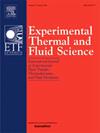小叶形状对 BMHV 左心室血流模式的影响
IF 2.8
2区 工程技术
Q2 ENGINEERING, MECHANICAL
Experimental Thermal and Fluid Science
Pub Date : 2024-10-28
DOI:10.1016/j.expthermflusci.2024.111343
引用次数: 0
摘要
当双叶机械心脏瓣膜通过手术植入人体后,下游左心室血流模式变得复杂,这与许多术后并发症直接相关。为了研究与机械心脏瓣膜设计相关的血流动力学特性,我们建立了一个左心循环搏动血流生成系统,以模拟生理条件下的左心室血流和压力。我们使用时间分辨粒子图像测速仪研究了两种双叶机械心脏瓣膜下游的左心室血流:一种是平面瓣叶,另一种是凸面瓣叶。对两种不同形状的双叶机械瓣下游血流进行了评估。实验结果表明,具有三重喷射模式的双叶瓣膜可形成拓扑结构复杂的三维涡流环。此外,强力喷射模式可在心室血流中引入高剪应力。与平面瓣膜相比,凸面瓣膜产生的射流速度分布更均匀,其涡流结构移动得更远,剪应力分布更直接、更连续。此外,凸面瓣膜涡流结构与左心室壁表面之间形成的通道非常有利于冲刷心尖位置,促进血液向主动脉口输送。因此,双叶机械瓣的瓣叶形状会对左心室血流模式和血液运输过程产生重大影响。合理优化瓣叶形状设计,改善机械瓣的血流动力学特性,可以减少瓣膜置换术后的并发症。本文章由计算机程序翻译,如有差异,请以英文原文为准。
Effect of leaflet shape on the left ventricular blood flow pattern in BMHVs
When a bileaflet mechanical heart valve is surgically implanted into the body, the downstream left ventricular blood flow pattern becomes complex, which is directly related to many postoperative complications. To investigate the hemodynamic properties associated with mechanical heart valve design, we built a left heart circulatory pulsatile flow generation system to simulate left ventricular flow and pressure under physiological conditions. We used time-resolved particle image velocimetry to study left ventricular blood flow downstream of two types of bileaflet mechanical heart valve: one with planar leaflets and one with cambered leaflets. Blood flow downstream of two different bileaflet mechanical valve shapes was assessed. The experimental results show that the bileaflet valve with a triple-jet pattern creates a three-dimensional vortex ring with a complex topology. In addition, the robust jet mode can introduce high shear stresses into the ventricular blood flow. Compared with the planar valve, the jet produced by the cambered valve has a more uniform velocity distribution, its vortex structure moves farther, and its shear stress distribution is more straightforward and continuous. Furthermore, the channel formed between the cambered valve vortex structure and the left ventricle wall surface is highly favorable for scouring the apical position and facilitating the transport of blood to the aortic orifice. Therefore, the shape of the leaflets of a bileaflet mechanical valve can significantly impact the left ventricular blood flow pattern and the blood transport process. Rational optimization of the design of the leaflet shape and improvement of the mechanical valve’s hemodynamic characteristics can reduce complications after valve replacement.
求助全文
通过发布文献求助,成功后即可免费获取论文全文。
去求助
来源期刊

Experimental Thermal and Fluid Science
工程技术-工程:机械
CiteScore
6.70
自引率
3.10%
发文量
159
审稿时长
34 days
期刊介绍:
Experimental Thermal and Fluid Science provides a forum for research emphasizing experimental work that enhances fundamental understanding of heat transfer, thermodynamics, and fluid mechanics. In addition to the principal areas of research, the journal covers research results in related fields, including combined heat and mass transfer, flows with phase transition, micro- and nano-scale systems, multiphase flow, combustion, radiative transfer, porous media, cryogenics, turbulence, and novel experimental techniques.
 求助内容:
求助内容: 应助结果提醒方式:
应助结果提醒方式:


